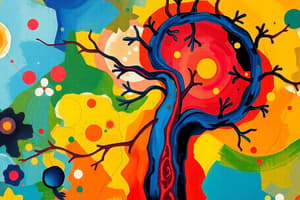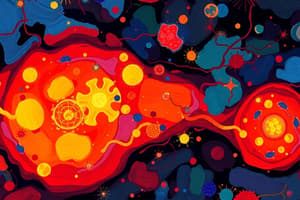Podcast
Questions and Answers
What type of healing occurs when there is minimal tissue loss?
What type of healing occurs when there is minimal tissue loss?
- Healing through repair
- Healing by secondary intention
- Healing by primary intention (correct)
- Healing through regeneration
What is the primary outcome of the repair process in healing?
What is the primary outcome of the repair process in healing?
- Prevention of infection
- Restoration of original tissue structure
- Formation of scar tissue (correct)
- Complete regeneration of all tissue
Which phase follows the reconstructive phase in wound healing?
Which phase follows the reconstructive phase in wound healing?
- Healing phase
- Inflammatory phase
- Maturation phase (correct)
- Reparative phase
What is a common factor that can lead to dysfunctional wound healing?
What is a common factor that can lead to dysfunctional wound healing?
What condition is described as a disruption where the wound pulls apart at the suture line?
What condition is described as a disruption where the wound pulls apart at the suture line?
What causes a contracture of scar tissue?
What causes a contracture of scar tissue?
Which factor is NOT typically associated with impaired wound healing in older adults?
Which factor is NOT typically associated with impaired wound healing in older adults?
What are newborns particularly at risk for due to age-related factors?
What are newborns particularly at risk for due to age-related factors?
Which factor contributes to ischemia related to dysfunctional wound healing?
Which factor contributes to ischemia related to dysfunctional wound healing?
In the healing process, what does the maturation phase primarily involve?
In the healing process, what does the maturation phase primarily involve?
What is the primary function of physical barriers in the innate immune system?
What is the primary function of physical barriers in the innate immune system?
Which of the following is NOT a hallmark of inflammation?
Which of the following is NOT a hallmark of inflammation?
Which system is primarily responsible for stopping bleeding during the inflammatory response?
Which system is primarily responsible for stopping bleeding during the inflammatory response?
What are the main products of the complement system involved in the immune response?
What are the main products of the complement system involved in the immune response?
Which factors contribute to the microscopic hallmarks of inflammation?
Which factors contribute to the microscopic hallmarks of inflammation?
Bradykinin in the kinin system is primarily responsible for which of the following effects?
Bradykinin in the kinin system is primarily responsible for which of the following effects?
The primary role of antibacterial peptides like defensins is to:
The primary role of antibacterial peptides like defensins is to:
What initiates the inflammatory response in vascularized tissue?
What initiates the inflammatory response in vascularized tissue?
Which of the following is NOT part of the three main lines of defence in the human immune system?
Which of the following is NOT part of the three main lines of defence in the human immune system?
What is the function of the complement system in the innate immune response?
What is the function of the complement system in the innate immune response?
What is the role of chemokines in the inflammatory process?
What is the role of chemokines in the inflammatory process?
Which interleukins are primarily associated with the proinflammatory response?
Which interleukins are primarily associated with the proinflammatory response?
How do mast cells contribute to the inflammatory response?
How do mast cells contribute to the inflammatory response?
What is the primary function of macrophages in the inflammatory response?
What is the primary function of macrophages in the inflammatory response?
Which statement best describes the process of phagocytosis?
Which statement best describes the process of phagocytosis?
What role do endothelial cells play during inflammation?
What role do endothelial cells play during inflammation?
What characterizes chronic inflammation compared to acute inflammation?
What characterizes chronic inflammation compared to acute inflammation?
What is the main function of opsonins in the immune response?
What is the main function of opsonins in the immune response?
What is the significance of interleukins in inflammation?
What is the significance of interleukins in inflammation?
During which phase of inflammation do neutrophils primarily function?
During which phase of inflammation do neutrophils primarily function?
Flashcards are hidden until you start studying
Study Notes
Human Defence Mechanisms
- Three lines of human defence against injury and infection: innate immunity, inflammatory response, and adaptive (acquired) immunity.
- Physical barriers such as skin and mucous membranes serve as the first line of defence against pathogens.
- Antibacterial peptides (cathelicidins, defensins, collectins, mannose-binding lectin) act as biochemical barriers in secretions like saliva, tears, and mucus.
- Commensal microorganisms on skin and mucous membranes protect against pathogens by chemical release and aiding digestion.
Inflammatory Response
- The inflammatory response is the second line of defence, a rapid and nonspecific reaction to cellular injury, limited to vascularized tissues.
- Macroscopic signs include redness, swelling, heat, pain, and loss of function.
- Microscopic signs involve vasodilation, increased capillary permeability, and cell fluid accumulation at the site of inflammation.
- Three plasma protein systems mediate inflammation: complement system, clotting system, and kinin system.
Complement System
- Activated by antigen-antibody reactions or bacterial polysaccharides; produces fragments that recruit phagocytes and destroy pathogens.
- Key products include C3b (opsonin), C3a, and C5a (both anaphylatoxins).
Clotting and Kinin Systems
- Clotting system helps stop bleeding and provides a scaffold for tissue repair.
- Bradykinin, an important kinin product, increases vascular permeability, smooth muscle contraction, and induces pain.
Regulation of Inflammation
- Inflammation is controlled through inactivating enzymes (carboxypeptidase, histaminase, C1 esterase inhibitor) and the fibrinolytic system.
- Various cells like mast cells, endothelial cells, platelets, and phagocytes (neutrophils, macrophages) play roles in inflammation.
Immune Cell Function
- Cells in the innate immune system release cytokines that activate other immune responses.
- Phagocytic cells, including neutrophils and macrophages, recognize pathogens through pattern recognition receptors (PAMPs and DAMPs).
- Cytokines such as chemokines and interleukins promote cell movement and inflammation regulation.
Phagocytosis Process
- Phagocytosis involves recognition, engulfment, phagosome formation, fusion with lysosomes, and destruction of pathogens.
- Opsonins enhance phagocytosis by binding to pathogens, making them easier targets.
Acute and Chronic Inflammation
- Acute inflammation is self-limiting, resolving within 8 to 10 days, characterized by local signs like redness, heat, swelling, and pain.
- Chronic inflammation may continue beyond two weeks, marked by lymphocyte and macrophage infiltration, potentially leading to granuloma formation.
Wound Healing
- Resolution refers to restoring tissue, while repair involves scar formation.
- Healing by primary intention occurs with minimal tissue loss. Secondary intention healing involves extensive tissue damage, resulting in scarring.
- Healing phases: reconstructive (beginning of healing) and maturation (remodelling of the healed wound).
- Dysfunctional healing may result from factors like ischemia, infection, diabetes, and tobacco use.
Age-Related Considerations
- Newborns exhibit depressed inflammatory function, affecting neutrophil chemotaxis and complement activity.
- Older adults face impaired wound healing due to chronic illnesses, increasing susceptibility to complications.
Studying That Suits You
Use AI to generate personalized quizzes and flashcards to suit your learning preferences.



